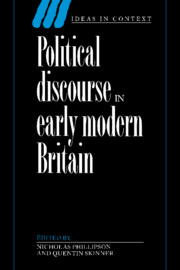Book contents
- Frontmatter
- Contents
- Contributors
- Preface
- PART I
- PART II
- PART III
- 9 Between Lambeth and Leviathan: Samuel Parker on the Church of England and political order
- 10 Priestcraft and the birth of Whiggism
- 11 The right to resist: Whig resistance theory, 1688 to 1694
- 12 Placing the Two Treatises
- PART IV
- PART V
- A bibliography of the writings of J. G. A. POCOCK
- Index
- Ideas in Context
11 - The right to resist: Whig resistance theory, 1688 to 1694
Published online by Cambridge University Press: 07 May 2010
- Frontmatter
- Contents
- Contributors
- Preface
- PART I
- PART II
- PART III
- 9 Between Lambeth and Leviathan: Samuel Parker on the Church of England and political order
- 10 Priestcraft and the birth of Whiggism
- 11 The right to resist: Whig resistance theory, 1688 to 1694
- 12 Placing the Two Treatises
- PART IV
- PART V
- A bibliography of the writings of J. G. A. POCOCK
- Index
- Ideas in Context
Summary
During and immediately after the Revolution of 1688–9, Englishmen faced an issue as important and troubling as any to be discussed in an early modern nation; did the people, however that word was understood, have the right to resist the king, and if so, on what grounds, to what degree, and through what agency? The circumstances of the Revolution and the need to legitimise it thereafter provoked intense debate among Whigs, Tories and Jacobites, who – their political thinking shaped by resistance theories that had been developed during the Reformation on the Continent and in Scotland, and in England during the Civil Wars, the Interregnum, and at the time of the Exclusion Crisis – argued questions concerning active resistance, passive resistance and non-resistance more comprehensively than ever before. My focus in this essay is on Whig resistance theory only. Mark Goldie has studied Tory resistance theory, especially as it was articulated by Anglican divines, and Paul Monod has illuminated Jacobite theory as expressed from 1688 to 1788. Whig resistance theory has also been studied by Richard Ashcraft, H.T. Dickinson and J.P. Kenyon, but not exhaustively for the years with which I am concerned. I will argue that Whig resistance theory from 1688 to about 1694 was richer and more complex than has been understood, that intellectual and ideological tensions existed within it, occasioned in part by the pressure of circumstances, the challenge of Tory and Jacobite criticism, and Whig views on other political issues, and that the theory, its tensions unresolved, was transmitted to the eighteenth century where it influenced British radicals throughout the era and American colonists at the time of their revolution.
- Type
- Chapter
- Information
- Political Discourse in Early Modern Britain , pp. 232 - 252Publisher: Cambridge University PressPrint publication year: 1993
- 4
- Cited by



